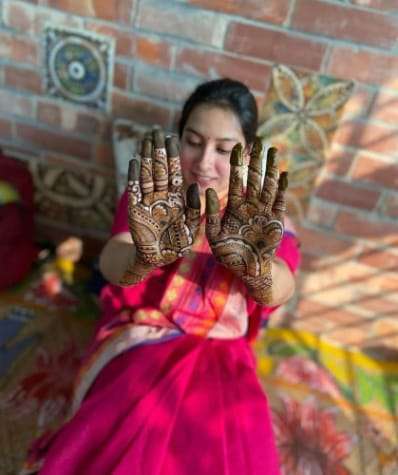What Is Mehndi?
Mehndi also known as henna is a captivating form of body art that has been cherished by people for a period. It is crafted using crushed leaves derived from the henna plant. When this unique paste is delicately applied on the skin, in patterns it creates a temporary design that adorns the body.
However, Mehndi encompasses more than its patterns. It holds value across various societies. It plays a role in celebrations and ceremonies, as a symbol of joy, beauty, and togetherness. Weddings and festivals often incorporate mehndi as a means to invoke luck while expressing love and extending wishes to those who wear it.
The color left behind by mehndi on the skin initially appears red. Gradually transforms into brown hues. This color signifies not only its appeal but also carries profound historical and traditional significance. It represents the promise of changes to come and reminds us that all beautiful things are ephemeral. As the design gradually fades away over time it serves as a reminder to cherish and relish moments before they pass.
Mehndi isn’t limited to occasions it serves as an expression of personal identity and individual preferences.
It’s an opportunity to stand out and be unique. With the fusion of traditional designs, mehndi is gaining popularity globally.
History Of Mehndi
The tradition of mehndi has a fascinating history dating back, to times even before our grandparent’s era. Its origins can be traced to both Egypt and India where people initially used it as a way to adorn their hands and feet with designs. Originally seen as a fun activity it became deeply intertwined with weddings and celebrations.
As time passed the practice of mehndi spread across regions like the Middle East, Africa, and parts of Europe and South Asia. Each culture added its touch to how they utilized mehndi, resulting in slight variations, from one community to another.
Initially regarded as a symbol of luck and joy mehndi gradually transformed into an emblem of happiness and love as it traveled from place to place. During weddings and special occasions, loved ones would come together to apply mehndi on their hands while enjoying each other’s company.
Today mehndi has evolved beyond being associated with events. It has become an art form that individuals engage in for enjoyment. Acting as a means of self-expression this ancient tradition continues to remain popular in times—a testament that certain things never go out of style.
Origin of Mehndi
Over the years mehndi has gone through a journey of transforming from a paste into an intricate art form. Talented mehndi artists have embarked on an adventure skillfully crafting patterns that often include symbols and motifs, with deep cultural and religious meanings. Ultimately these mesmerizing mehndi designs have become a medium, for storytelling effectively expressing emotions, beliefs, and narratives.
Significance Of Mehndi
Mehndi holds significance in cultures symbolizing joy, festivity, and love. It encompasses not only designs but also a sense of tradition and togetherness. For years people have utilized mehndi to mark occasions such, as weddings and celebrations believing that it brings good fortune and happiness.
Mehndi, with its designs and beautiful patterns, carries cultural meaning. It is more than an art; it represents moments of happiness and important milestones in life. Whether it’s a wedding or a festival mehndi has always been a component of celebrations symbolizing luck, love, and new beginnings. It embodies the bonds of affection, within families and communities fostering a sense of unity and togetherness.
Cultural Significance
Mehndi goes beyond cultural boundaries bringing hearts and communities together. It holds significance in Hinduism, Islam, and Sikhism traditions. In Hindu culture mehndi is an element of occasions, like Diwali and Karva Chauth symbolizing devotion and joy. Similarly, in Islam, mehndi adorns the hands during Eid and other special events. The charm of Mehndi reaches across North Africa and the Middle East, where it forms a part of traditional ceremonies and joyous celebrations.
Global Reach
The popularity of Mehndi has seen a surge, in years crossing boundaries and becoming a symbol of beauty and self-expression worldwide. Henna tattoos, incorporating elements now grace the hands and bodies of individuals from different backgrounds. The history and origins of Mehndi take us on a journey through time and culture from Egypt’s mysterious sands to the rich tapestry of traditions in India and beyond. Mehndi stands as a timeless representation of beauty, celebration, and cultural richness. A testament, to the enduring narrative power of this art form that continues to inspire even today.
